It's hard to believe that this delicious vegetable is actually the tops of a kind of beet. The name "swiss chard" comes from the extensive cultivation of this vegetable in Switzerland, but it is also widely valued in the mediterranean regions of Europe as well. I love swiss chard so much, that personally, I can eat it as a main meal, without any additional sides. (Well, maybe a glass of wine)
SAUTEED SWISS CHARD 1 large batch of Swiss chard, Chopped Olive oil as needed 1 onion, sliced Salt and pepper to taste 2 cloves garlic, chopped 2 oz. sherry 1 tablespoon sherry vinegar Heat a large skillet, add the oil, add onion until translucent, and then the chard leaves, salt and pepper. When the chard has reduced and starts to soften add the garlic and sauté one more minute. Add the sherry and the vinegar and cook on high until at least half the fluid has evaporated. Add additional salt and pepper if necessary and serve. If you would like to include the stems with the leaves, chop them and sauté them first. Being harder they will need a head start. Other optional ingredients include chopped shallots, diced bell pepper, or a sprinkle of nutmeg. Sauté the shallots and bell pepper with the chard leaves before adding the garlic.
1 Comment
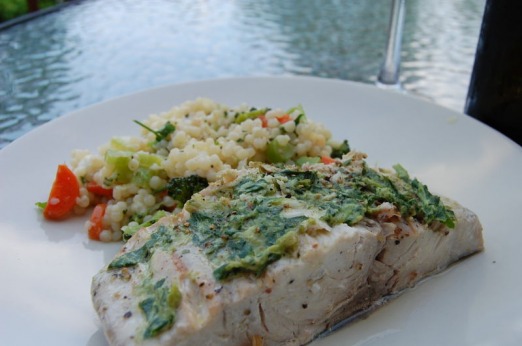 I bet anyone who likes the beach and seafood is really upset about the oil spill incident that recently occured in the Gulf. I, for one am VERY heartbroken and concerned about the future impact to the flora and fauna of the underwater world. So, it is with a sad heart and a mourning spirit, that Nic and I decided to treat ourselves to a gulf delicasy of Mahi-Mahi, along with an Israeli couscous salad with mixed vegetables. In case you are not acquainted with delicious mahi-mahi, first let me say that although it is sometimes called "dolphin-fish", it is NOT related to the DOLPHIN as we know it! 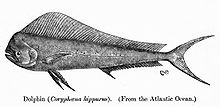 This is an illustration of the Mahi fish. These fish are surface dwelling, ray-finned fish found in off shore temperate, tropical, and sub tropical waters around the world. they average somewhere between 15- 29 pounds,and have a mild taste similar to whitefish, tilapia, or flounder. Pesto Sauce: 1/3 cup of olive oil 1 clove of garlic juice of one lemon dash of salt half cup cherry or grape tomatoes 1/3 cup of chopped basil leaves 3-4 tablespoons of chopped flat leaf parsley Directions: Mix all the ingredients together in a food processor. Set aside Oven Seared Mahi-Mahi with Pesto Serves 2 2 mahi-mahi filets 3 tablespoons pesto 2 Tbsp olive oil Kosher salt and black pepper Extra olive oil for greasing pan 1. Grease a glass baking dish with a very small amount of olive oil. 2. Season both sides of the mahi-mahi with salt and pepper and then coat the top of each mahi-mahi filet with 1Tbsp olive oil 3. Place the filets in the baking dish, and bake at 350 degrees for 15-20 minutes, or until the fish flakes easily with a fork. Top with pesto and serve immediately. Mixed Vegetable Israeli Couscous 2 cups chicken broth or water 1 cup Israeli couscous 1 teaspoon olive oil 1/2 teaspoon salt 3/4 cup chopped grape tomatoes or cherry tomatoes, cut in half 3/4 cup chopped broccoli 1/4 cup chopped red onion 3 green onions, chopped 1/2 cup chopped parsely 1/2 teaspoon hot pepper flakes (optional) Juice of 1 lemon 3 tablespoons olive oil Salt and pepper to taste Bring broth or water to boil. Add couscous, olive oil and salt. Simmer for about 10 to 12 minutes or until tender to the bite. Drain and cool couscous. Combine couscous with broccoli, tomatoes, red onion, parsley and hot pepper flakes. Whisk together remaining ingredients and combine with couscous mixture. Season with additional salt and pepper to taste. Makes 4 to 6 large side servings. 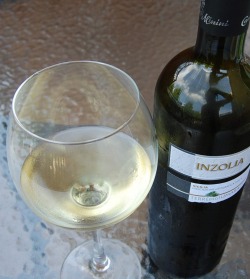 2008 Terre di Giumara Inzolia
Inzolia is one of the oldest native white grapes of Sicily. It is planted also in Sardinia, Latium and Tuscany, where it is known as Ansonica. Its vine is very resistant to the dry weather and has sparse foliage, requiring less water. This is one of the three main grape varieties used in Marsala production, but it is often bottled as a dry white table wine. This wine is fermented at controlled temperature for 20 days, then aged 4 months in stainless steel tanks and 2 months in the bottle. Tasting notes: It has a light golden color. The nose opens with tangerine, ripe pear and minerals, but it translates to citrus fruit and chamomile flowers on the palate. Light bodied and tart with a persistent and intense finish. (retail $11.99 - AVIN6719568292348). Originally, this dish known as BUCATINI ALL'AMATRICIANA, because it was named for the tiny town of Amatrice located about 100 miles east of Lazio from Abruzzo, near Rome. But we are calling this dish ALL'AMERICANA because we slightly changed the traditional ingredients, and added some local flair. Serves 4 1/4 pound american bacon(we used the organic kind) half pound ground buffalo 3 garlic cloves 1 red onion, halved and sliced ½-inch thick 1 ½ teaspoons hot red pepper flakes Kosher salt and freshly ground black pepper, to taste 1 ½ cups basic tomato ragu(we used a jar brand) 1 pound bucatini dried pasta 1 bunch of flat-leaf parsley, leaves only Pecorino Romano, for grating 1. Bring 6 quarts of water to a boil and add 2 tablespoons of salt. 2. Place the bacon slices in a 12- to 14-inch sauté pan in a single layer and cook over medium-low heat until most of the fat has been rendered from the meat, turning occasionally. Remove the meat to a plate lined with paper towels and discard half the fat, leaving enough to coat the garlic, onion and red pepper flakes. Brown the buffalo in the same pan until done. Return the bacon to the pan with the vegetables, and cook over medium-high heat for 5 minutes, or until the onions, garlic and bacon are light golden brown. Season with salt and pepper, add the sauce, reduce the heat, and simmer for 10 minutes. 3. Cook the bucatini in the boiling water according to the package directions, until al dente. Drain the pasta and add it to the simmering sauce. Add the parsley leaves, increase the heat to high and toss to coat. Divide the pasta among four warmed pasta bowls. Top with freshly grated Pecorino cheese and serve immediately. 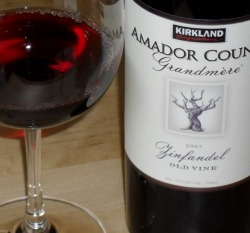 2007 Kirkland Signature Grandmère Amador County Old Vine Zinfandel
Since the bucatini have been made "all' Americana", I picked the American wine for excellence to pair with the dish: red Zinfandel. I would not do it for the Italian style pasta, but the addition of bison meat asks for a bigger wine. Kirkland is Costco's private label, and I have purchased this wine because I'm tasting it along with other variety for a post on b8wine. Tasting notes: Dark ruby color. Deep nose of blackberry, black cherry, spices and mocha. Full bodied with round tannins and silky texture. Meaty and jammy. It has layers of ripe dark fruit and mocha with some pepper on the top. Well balanced acidity and a lingering finish with aftertaste of coffee beans. This wine is big and ripe (the fruit tastes almost sweet) and has 15.5% ALC without being hot. The price in Georgia is $12.99, and overall it's a good value. |
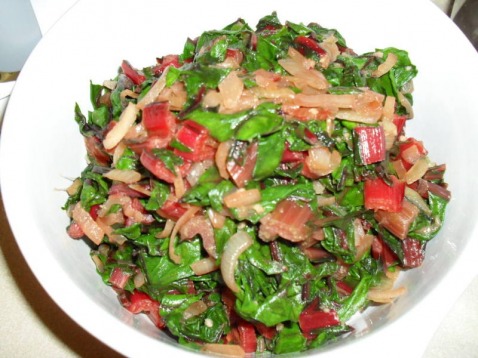
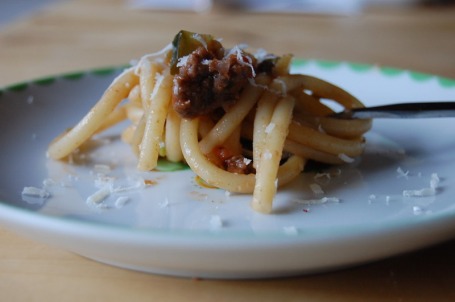

 RSS Feed
RSS Feed